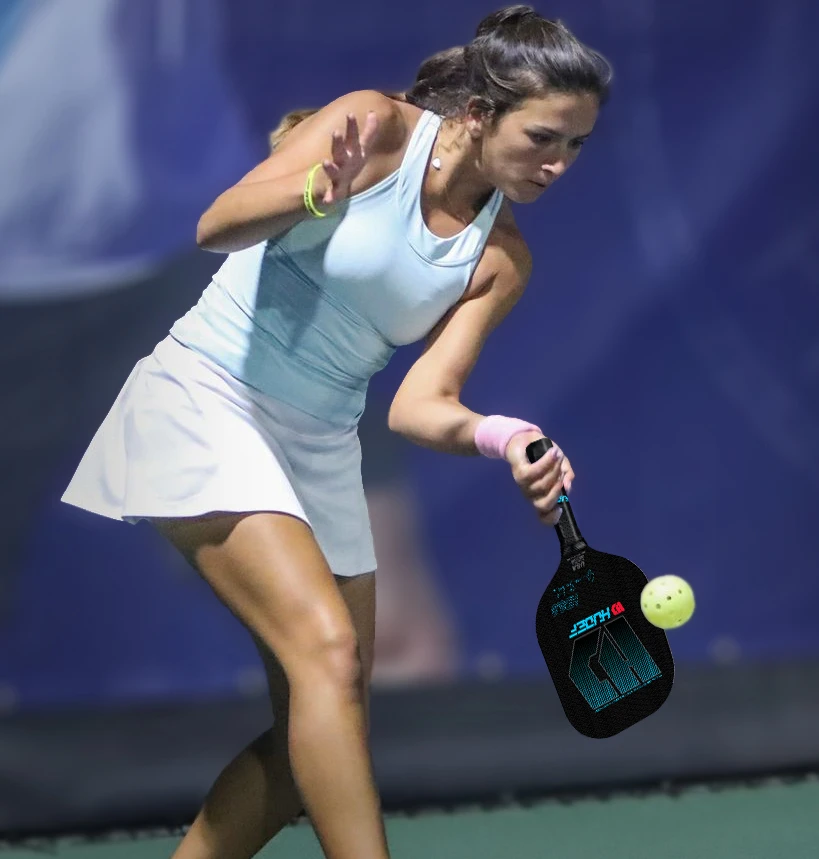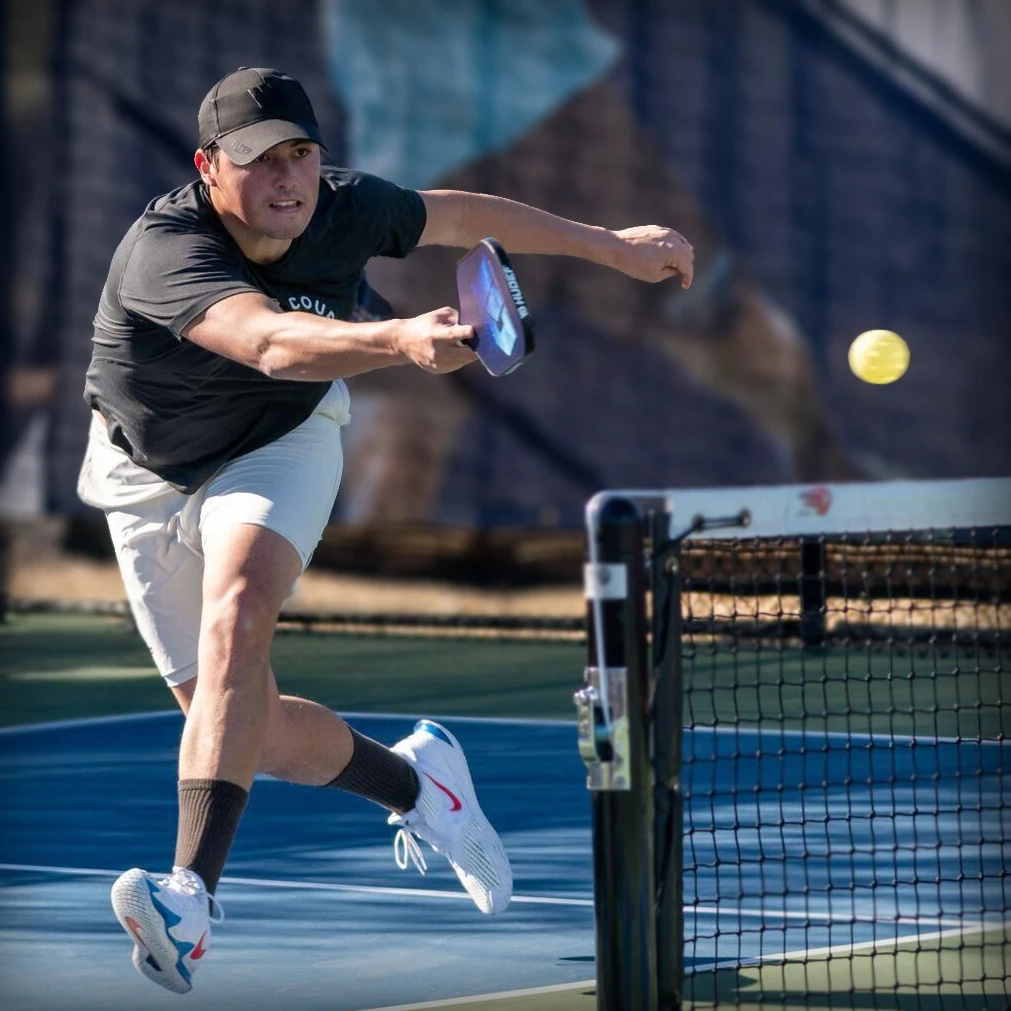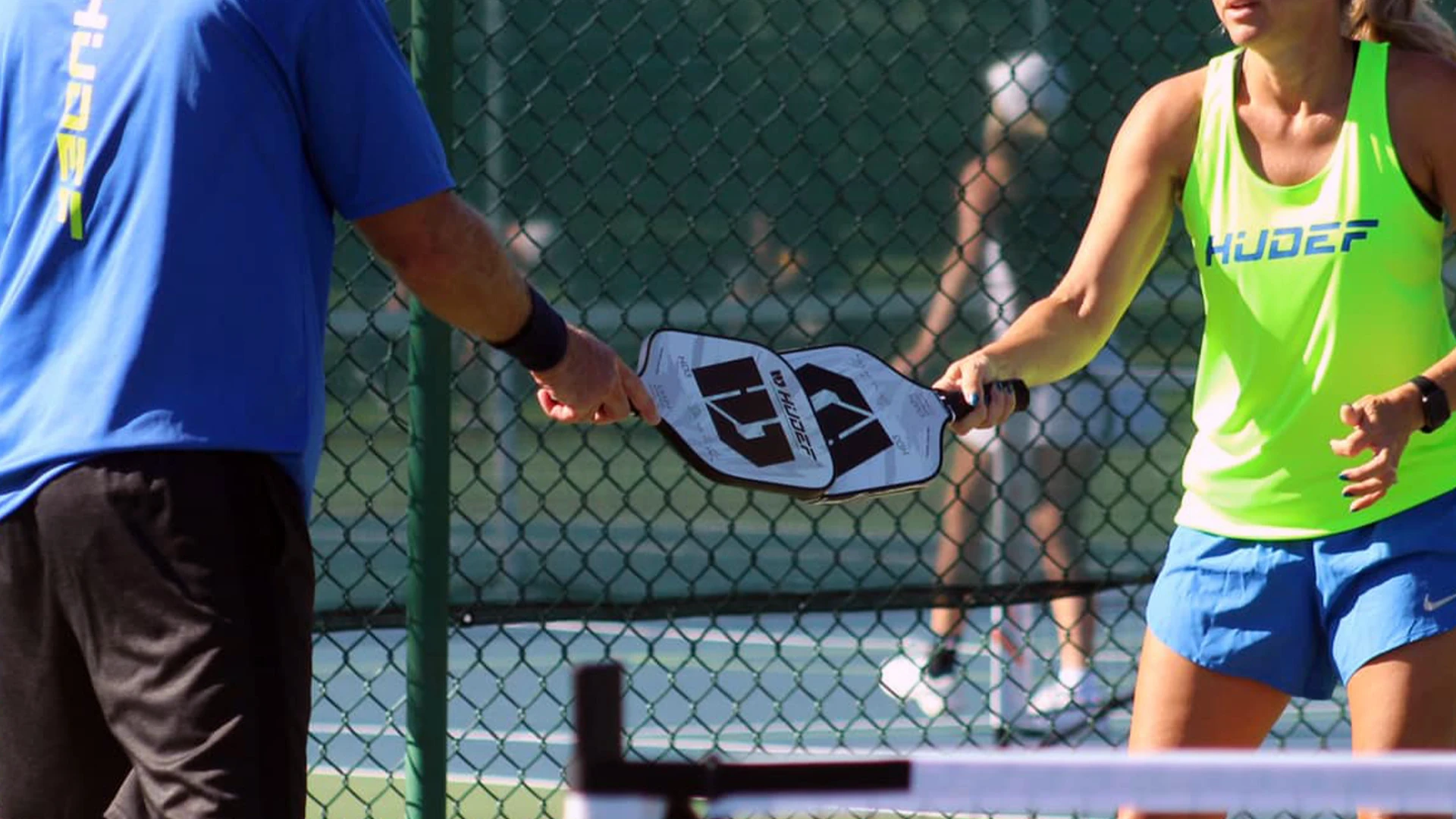
You may notice that Beginner Pickleball Rackets Cut Errors 60% for many players. When you start pickleball, you might miss the sweet spot on your paddle. Many paddles vibrate after each pickleball hit. Some paddles lose control fast. You want a paddle that helps you enjoy pickleball. The right pickleball paddles from hudef give you more power and control. Try a new pickleball paddle to feel the difference. Good paddles improve your pickleball skills. You need paddles that last longer and feel better in your hand. Pickleball becomes easier with the right paddles. Great paddles change how you play pickleball every day.
Key Takeaways
-
Picking a pickleball paddle with a big sweet spot helps you make fewer cut errors. It also gives you better control. - Beginners need to learn the right grip and good footwork. They should look for paddles with a honeycomb core. This helps them play better and make fewer mistakes. - The right paddle lets you play longer without hurting. It helps you feel more sure of yourself. You will have more fun playing pickleball.
Cut Errors in Pickleball
What Are Cut Errors
You may hear the term "cut errors" when you play pickleball. Cut errors happen when you hit the ball with the edge or outside the sweet spot of your paddle. This mistake causes the ball to lose speed and control. You want your paddle to hit the ball in the center. If you use paddles with a small sweet spot, you will notice more cut errors. Many beginners use paddles that do not help them find the best hitting zone. You may feel the ball bounce off your paddle in strange ways. Some paddles make the ball spin too much or not enough. You need paddles that help you make clean contact every time.
Tip: Try to watch where the ball meets your paddle. Good paddles make it easier to see and feel the sweet spot.
Impact on Beginners
Cut errors affect new pickleball players the most. You may feel frustrated when your paddle does not send the ball where you want. Many paddles vibrate after a bad hit. This vibration can make your hand and arm tired. You may lose control of the ball and miss easy shots. Some paddles wear out fast, which makes cut errors happen more often. You want paddles that last longer and keep their shape. If you use paddles with a larger sweet spot, you will make fewer mistakes. Good paddles help you learn faster and enjoy pickleball more. You will see your skills improve when you choose the right paddle.
-
Look for paddles with shock absorption.
-
Choose paddles with a strong surface.
-
Pick paddles with a bigger sweet spot.
You can reduce cut errors and play pickleball with more confidence.
Beginner Pickleball Rackets Cut Errors 60%

Causes of High Error Rate
You may wonder why beginner pickleball rackets cut errors 60% for new players. The main reason comes from the design of many entry-level paddles. Most beginner paddles have a small sweet spot. The sweet spot is the area on your paddle that gives you the best control and power. When the sweet spot is small, you have a higher chance of hitting the ball off-center. Off-center hits cause the ball to lose speed and go in the wrong direction. You may feel frustrated when your shots do not go where you want.
A paddle with a low twistweight means it has a smaller sweet spot. This makes the paddle less forgiving. You need to hit the ball in the perfect spot every time. If you miss, you will see more cut errors. Many beginners struggle with this because they are still learning how to control their swings. The result is that beginner pickleball rackets cut errors 60% of the time.
Vibration is another big problem. When your paddle vibrates after a hit, it sends shock into your hand and arm. This can cause pain or even injuries like tennis elbow. You may start to grip the paddle too tightly or change your swing to avoid discomfort. These changes make it even harder to control the ball. Vibration also makes your shots less stable. You may notice your paddle shakes, and your shots become inconsistent. Fatigue sets in quickly, and you lose confidence on the court.
Poor ball control adds to the problem. Many beginner paddles do not help you guide the ball. You may try to hit with power or spin before you master the basics. This leads to more mistakes and more cut errors. When you use paddles that do not support your learning, you see why beginner pickleball rackets cut errors 60% for new players.
Technical solutions can help. Paddles with a honeycomb core give you a larger sweet spot. This design spreads the impact across the paddle, making it easier to hit the ball cleanly. Shock absorption features, like foam layers or special edge guards, reduce vibration. You feel less pain and play longer. Durable surfaces keep your paddle in good shape, so you do not lose control as the paddle wears out. These features help you lower your error rate and enjoy pickleball more.
Tip: Choose paddles with a honeycomb core and shock absorption to make your game easier and more comfortable.
Common Mistakes
Many beginners make the same mistakes when using entry-level paddles. These mistakes increase the chance that beginner pickleball rackets cut errors 60%. You can avoid these problems by learning what to watch for and how to fix them.
|
Common Beginner Mistake |
Description and Impact on Entry-Level Racket Use |
Recommended Solution |
|---|---|---|
|
Improper Grip |
Gripping the paddle too far into the palm reduces control and power. |
Use the continental grip. Place the V between your thumb and index finger on the top bevel. |
|
Overly Long Paddle Swings |
Long swings cause inconsistent control and pop-ups. |
Shorten your swing. Make contact in front of your body. Keep the paddle in your peripheral vision. |
|
Faulty Footwork |
Poor movement reduces stroke quality and paddle use. |
Use the split step. Stay balanced and ready for each shot. |
|
Poor Ready Position |
Standing flat-footed with the paddle at your side slows your reaction. |
Stay in an athletic position. Bend your knees and hold the paddle in front. |
|
Doing Too Much Too Soon |
Trying advanced shots before mastering basics leads to bad habits. |
Focus on grip, footwork, and consistent strokes first. |
|
Fear of the Non-Volley Zone |
Staying back limits your paddle use near the net. |
Learn to approach the NVZ with confidence. |
|
Challenging the Net Incorrectly |
Hitting shots too low over the net increases errors and affects paddle control. |
Aim higher over the net to reduce mistakes and force errors from your opponent. |
You may also see mistakes like excessive backswing or hitting every ball too aggressively. Large backswings make it hard to control the paddle. You may pop the ball up or miss the sweet spot. Trying to win every point with power leads to unforced errors. You need to use restraint and choose the right shot for each situation.
Modern paddles with honeycomb cores and shock absorption help you avoid these mistakes. The honeycomb core gives you more dwell time and a bigger margin for error. Shock absorption features reduce arm fatigue and make it easier to handle soft shots. These technical features support your learning and help you play longer without pain.
Note: Start with a paddle that focuses on control and comfort. This helps you build good habits and reduce cut errors.
You can see why beginner pickleball rackets cut errors 60% for new players. Small sweet spots, vibration, and poor ball control all play a part. By choosing the right paddle and learning the basics, you can lower your error rate and enjoy pickleball even more.
Common Errors
Off-Center Hits
You often hit the ball off-center when you first start playing pickleball. This happens because many beginner paddles have a sweet spot that is hard to find. If you miss the sweet spot, your paddle loses power and control. Standard paddle shapes with a centered sweet spot help you keep rallies going, even if you do not hit the ball perfectly. Elongated paddles make off-center hits more common, so you should choose paddles with a generous sweet spot. You will notice that thicker cores in paddles absorb impact and keep your wrist safe during these mishits.
Tip: Try paddles with a polymer core and a balanced shape to reduce off-center hits.
Ball Control Issues
Ball control is a challenge for many new pickleball players. You may see the ball bounce in strange ways or fly off your paddle unpredictably. The plastic pickleball can crack or lose its shape, which makes control harder. Different surfaces and weather also change how the ball moves. Softer balls bounce higher and may be easier to manage, but you need paddles that help you guide the ball. If you use paddles with a textured surface, you can improve your control and keep your shots consistent.
Vibration Problems
Vibration from your paddle can make your hand tired and affect your play. Studies show that high-frequency vibration causes grip fatigue and slower reaction times. Stiffer paddles or those with thin cores send more vibration to your arm. You may feel buzzing in your hand, especially during tense moments. Many paddles now use shock-absorbing materials to help you play longer without discomfort. You should look for paddles with a foam layer or a gel handle to reduce vibration.
Surface Wear
Surface wear on your paddle leads to dead spots. These areas lose their bounce and make your shots unpredictable. As your paddle wears out, you will see more errors and feel less confident. Dead spots can make you nervous and affect your game. Regular maintenance and choosing paddles with durable surfaces help delay these problems. You should replace your paddle when you notice it losing its rebound.
Reducing Errors

Paddle Features
You want a paddle that helps you make fewer mistakes. Pick a paddle with a thick honeycomb core. This gives you a bigger sweet spot. It also helps if you hit the ball off-center. A standard or hybrid shape makes the ball easier to control. Choose a paddle that weighs about 7.8 to 8.1 ounces. This weight keeps your swings steady and feels good in your hand. Look for shock absorption, like soft grips or layers that stop vibration. These features protect your arm and let you play longer. Paddles made with carbon fiber or graphite last longer. They also help you keep control of your shots. Textured faces on paddles help you aim the ball better.
|
Feature |
Why It Matters for Beginners |
|---|---|
|
Thick Core |
Bigger sweet spot, more forgiveness |
|
Standard Shape |
Easier control, fewer cut errors |
|
Midweight |
Stable swings, less fatigue |
|
Shock Absorption |
Reduces vibration, protects joints |
|
Durable Surface |
Longer life, steady performance |
|
Textured Face |
Better ball placement and control |
Choosing the Right Racket
Choosing your first pickleball paddle can be hard. Use this checklist to help you pick a good one:
-
Pick a paddle that helps you control the ball.
-
Choose a paddle with a big sweet spot.
-
Pick a standard or widebody shape for easy hits.
-
Make sure the grip fits your hand. Measure from your palm to your ring finger.
-
Look for a handle that is 5.25 inches or shorter. Short handles help you control the paddle.
-
Start with a paddle that costs less than $200.
-
Try paddles made of composite or graphite for good spin and feel.
Tip: Try out different paddles before you buy one. The right paddle helps you learn faster and have more fun.
Practice Tips
You can make fewer mistakes by doing simple drills. Practice cross-court dinks to get better at control. Work on forehand and backhand drives to improve your shots. Practice serving and returning to start rallies strong. Try hitting the ball against a wall to practice real-game moves. Do partner mirror drills to get better at timing. Catch and serve drills help your hand-eye coordination. Bounce the ball on the edge of your paddle to build focus. Do footwork drills like split steps and shuffle steps to move better.
Mental practice helps too. Picture yourself making good shots before you play. Take deep breaths to stay calm and focused. Tell yourself positive things to stay confident. After each game, think about what you did well and what you can do better. These habits help you become a better pickleball player.
You will make more mistakes in pickleball if your paddle is hard to use. A small sweet spot, bad grip, or heavy paddle can cause problems.
-
Pick paddles with big sweet spots, even weight, and soft cores.
-
Using the right paddle helps you get better and feel more sure of yourself.
Have fun playing pickleball and be proud of every step you take!
FAQ
What makes a good beginner paddle?
You want a paddle with a large sweet spot. This helps you hit the ball cleanly. A comfortable grip and shock absorption also help you play better.
How often should you replace your paddle?
You should replace your paddle if you see cracks or dead spots. Most paddles last one to two years with regular pickleball play.
Can a new paddle lower your error rate?
Yes. A new paddle with a bigger sweet spot and better shock absorption helps you control the ball. You will make fewer mistakes during pickleball games.














